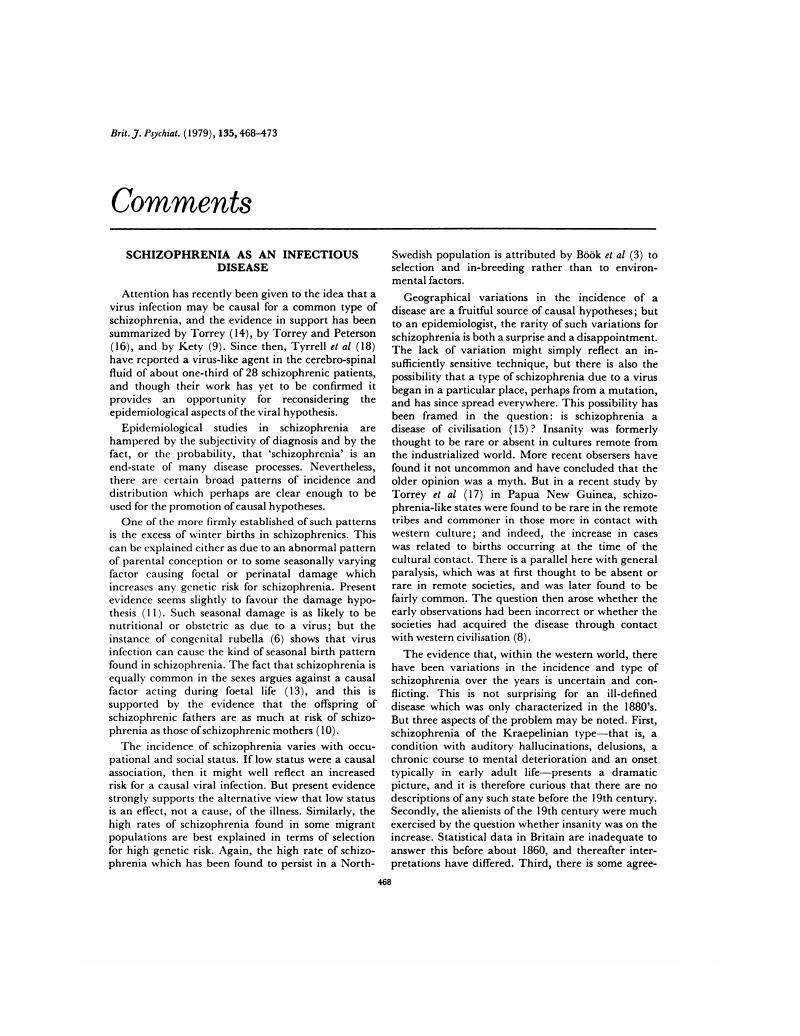Crossref Citations
This article has been cited by the following publications. This list is generated based on data provided by Crossref.
Bleich, Avraham
Munitz, Hanan
and
Wijsenbeek, Henricus
1982.
Schizophreniform episode with infectious mononucleosis.
Psychosomatics,
Vol. 23,
Issue. 10,
p.
1067.
King, D. J.
Cooper, S. J.
Earle, J. A. P.
Martin, S. J.
McFerran, N. V.
Rima, B. K.
and
Wisdom, G. B.
1985.
A Survey of Serum Antibodies to Eight Common Viruses in Psychiatric Patients.
British Journal of Psychiatry,
Vol. 147,
Issue. 2,
p.
137.
Eagles, John M.
and
Whalley, Lawrence J.
1985.
Decline in the Diagnosis of Schizophrenia among First Admissions to Scottish Mental Hospitals from 1969–78.
British Journal of Psychiatry,
Vol. 146,
Issue. 2,
p.
151.
Bark, Nigel M.
1985.
Did Shakespeare know Schizophrenia?.
British Journal of Psychiatry,
Vol. 146,
Issue. 4,
p.
436.
Mendlewicz, J.
and
Sevy, S.
1986.
Vol. 65,
Issue. ,
p.
1.
Hafner, H.
Haas, S.
Pfeifer-Kurda, M.
Eichhorn, S.
and
Michitsuji, S.
1987.
Abnormal seasonality of schizophrenic births A specific finding?.
European Archives of Psychiatry and Neurological Sciences,
Vol. 236,
Issue. 6,
p.
333.
Crow, T. J.
1987.
The Dopamine Hypothesis Survives, but There Must Be a Way Ahead.
British Journal of Psychiatry,
Vol. 151,
Issue. 4,
p.
460.
Barrett, Robert J.
1988.
Interpretations of schizophrenia.
Culture, Medicine and Psychiatry,
Vol. 12,
Issue. 3,
p.
357.
Eagles, J. M.
Hunter, D.
and
McCance, C.
1988.
Decline in the Diagnosis of Schizophrenia among First Contacts with Psychiatric Services in North-East Scotland, 1969–1984.
British Journal of Psychiatry,
Vol. 152,
Issue. 6,
p.
793.
King, David J.
and
Cooper, Stephen J.
1989.
Viruses, Immunity and Mental Disorder.
British Journal of Psychiatry,
Vol. 154,
Issue. 1,
p.
1.
Eagles, John M.
1991.
The Relationship Between Schizophrenia and Immigration are There Alternatives to Psychosocial Hypotheses?.
British Journal of Psychiatry,
Vol. 159,
Issue. 6,
p.
783.
Folnegovic, Z
and
Folnegovic-Smalc, V
1992.
Schizophrenia in Croatia: interregional differences in prevalence and a comment on constant incidence..
Journal of Epidemiology & Community Health,
Vol. 46,
Issue. 3,
p.
248.
Munk-J⊘rgensen, Povl
and
Mortensen, Preben Bo
1992.
Incidence and Other Aspects of the Epidemiology of Schizophrenia in Denmark, 1971–87.
British Journal of Psychiatry,
Vol. 161,
Issue. 4,
p.
489.
Adityanjee
Aderibigbe, Yekeen A.
Theodoridis, D.
and
Vieweg, W. Victor R.
1999.
Dementia praecox to schizophrenia: The first 100 years.
Psychiatry and Clinical Neurosciences,
Vol. 53,
Issue. 4,
p.
437.
Goldberg, Abbie E.
and
Newlin, David B.
2000.
Season of Birth and Substance Abuse: Findings From a Large National Sample.
Alcoholism: Clinical and Experimental Research,
Vol. 24,
Issue. 6,
p.
774.
Goldberg, Abbie E.
and
Newlin, David B.
2000.
Season of Birth and Substance Abuse: Findings From a Large National Sample.
Alcoholism: Clinical and Experimental Research,
Vol. 24,
Issue. 6,
p.
774.
Pearce, Bradley D.
2003.
Can a Virus Cause Schizophrenia?.
Vol. 6,
Issue. ,
p.
1.
Martin, W. John
2019.
Renegade cellular and bacterial genetic sequences in monkey-derived stealth adapted viruses .
Journal of Human Virology & Retrovirology,
Vol. 7,
Issue. 2,
p.
26.




eLetters
No eLetters have been published for this article.